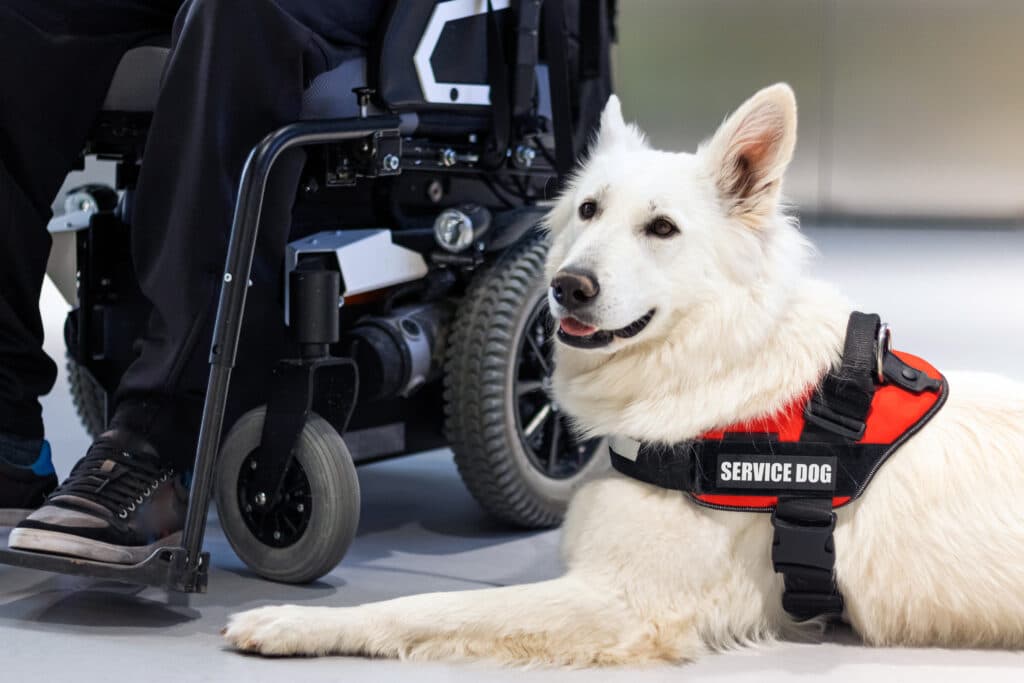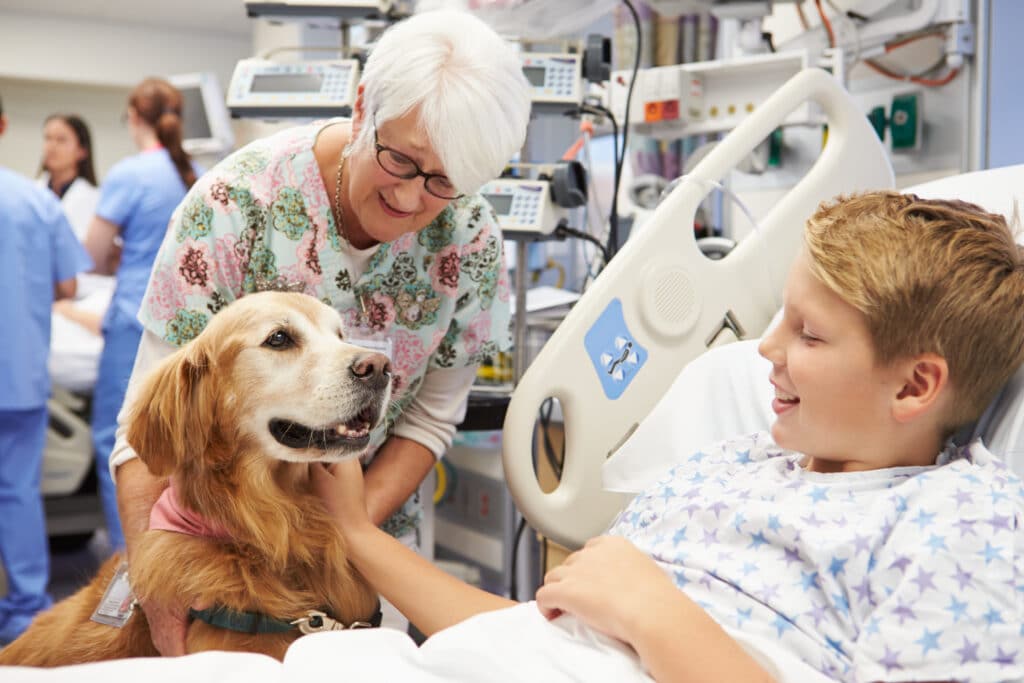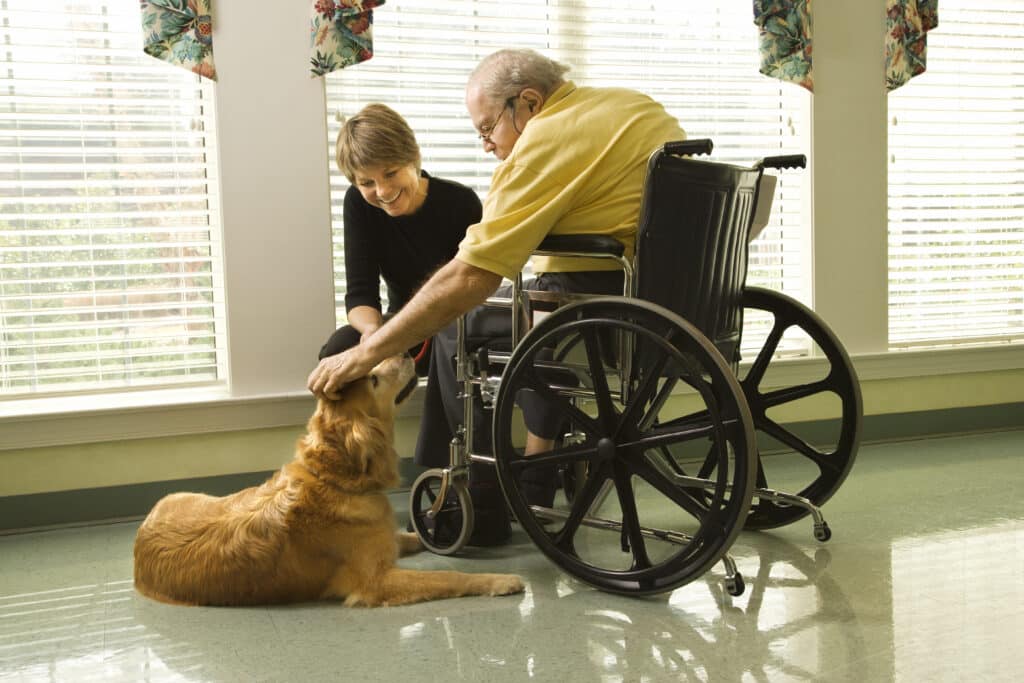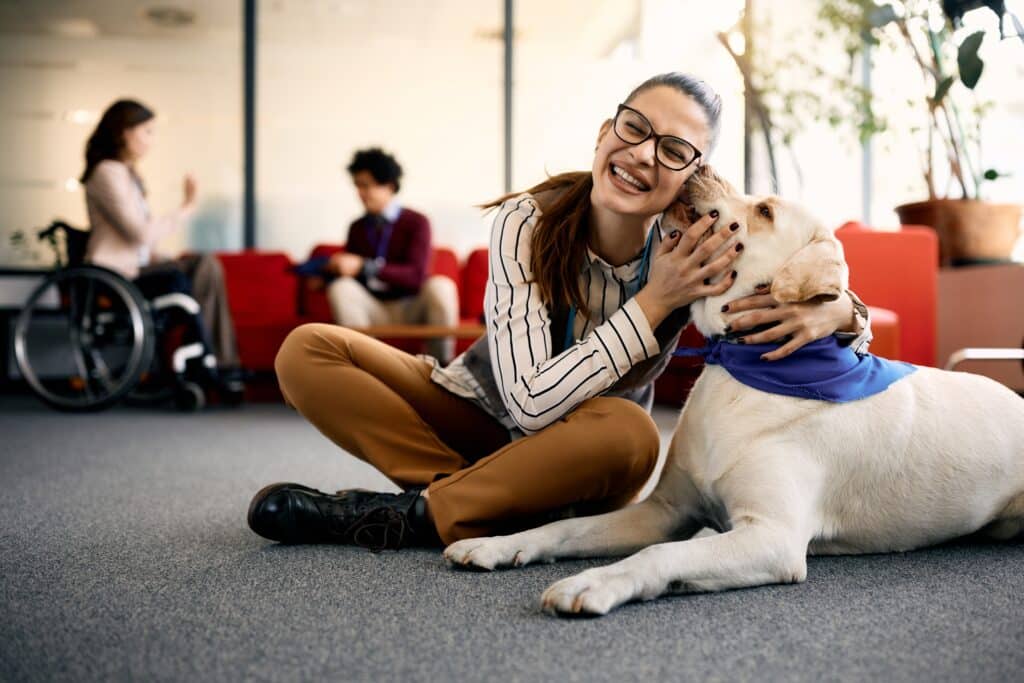
The month of May is Mental Health Awareness Month. And we’re taking this opportunity to highlight the important role that dogs play in supporting and improving not only our physical health, but also our mental health.
In this article, we’ll talk about what therapy dogs are and the positive impact they have on our overall health.
What Is A Therapy Dog?
A therapy dog is trained to offer support, in the form of love and affection, to different people in a wide variety of settings such as schools, nursing homes, and hospitals.
Thanks to their loving and friendly disposition, they are able to provide comfort to those who face mental health challenges such as anxiety, dementia, high blood pressure, and/or post-traumatic stress disorder (PTSD).
Characteristics Of A Good Therapy Dog

While there are no age or breed restrictions to become a therapy dog, not every dog is cut out for the job. But what makes a good therapy dog? There are several important characteristics to consider, and they’re the following:
- A calm, friendly, and gentle temperament: A good therapy dog should naturally be gentle, calm, patient, and friendly. They should be willing, comfortable, and patient when interacting with people of all ages and backgrounds, from little children, to old people, to those experiencing emotional distress.
- Well-socialized: Along with their temperament, a good therapy dog should be well-socialized, starting from a young age. This way, they can easily adapt to any new environment, can be intuitive, and quickly detect changes in someone’s behavior or surroundings.
- Can be easily trained and is obedient: A good therapy dog should be easily trained and should be obedient at all times. They should be able to follow basic commands such as “sit”, “stay”, “come”, “leave it” to more complex commands needed for therapy work.
- Good behavior in public settings: Being well-behaved in a public setting is important for a therapy dog. While they should always be open to interacting with strangers, they should not jump at or paw at people. And they should also be able to walk on a leash without pulling.
- Healthy and well-groomed: A good therapy dog should be in good physical health, is clean, and well-groomed. Having up-to-date vaccinations and regular grooming sessions will ensure that the dog is always ready and presentable during therapy visits.
Breeds That Make Good Therapy Dogs

As mentioned above, there are no age and breed restrictions for therapy dogs as long as they have the right personality for it. However, these 14 breeds have been named by the US Service Animals to have most of the qualities people look for in a therapy dog:
- Labrador Retriever
- Golden Retriever
- Poodle
- Newfoundland
- Border Collie
- Cavalier King Charles Spaniel
- Bichon Frise
- Yorkshire Terrier
- Corgi
- Papillon
- Pug
- Greyhound
- Beagle
- Dachshund
What these dog breeds have in common is the temperament to handle therapy work. They are smart, therefore easy to train, friendly, loving, calm, and well-mannered.
Therapy Dogs VS Service Dogs VS Emotional Support Dogs: The Difference

Dogs are a man’s best friend for a LOT of reasons. They have helped us make our lives a lot easier by taking up different roles and jobs.
And service dogs, therapy dogs, and emotional support dogs all fulfill important roles. However, their job descriptions are not the same. Here, we’ll discuss each category so you’ll see the difference between them.
Therapy Dogs
Therapy dogs are trained to provide emotional support to many different people in various settings such as schools, hospitals, and nursing homes. And their handler (usually their owner) volunteer in different places where people work in stressful situations.
Unlike service and emotional support dogs, they render their services to a lot of people instead of one person only. Therapy dogs are also trained to be friendly, calm, and patient. They need to be able to be comfortable in new environments and be able to interact with a wide variety of people while working.
Furthermore, while therapy dogs do amazing work for humans, they do not have the same legal rights as service dogs.
Service Dogs
The Americans with Disabilities Act (ADA) describes service dogs as trained dogs who perform tasks directly related to a person’s disability.
Since service dogs perform specific tasks to help their owners, they are allowed in public places that do not usually allow pets like restaurants, hospitals, shops, hotels, etc.
And unlike therapy dogs, they should not be pet by people in public while they’re working with their owner because that can distract them from their job.
A few examples of tasks performed by service dogs include:
- Reminding and/or alerting their owner with depression to take their medication.
- Retrieving objects or opening doors for their owner that is wheelchair-bound.
- Alerting their owner who has PTSD of an oncoming panic attack.
- Detecting the onset of a seizure and helping their owner who has epilepsy stay safe during the seizure.
- Alerting their owner to any heart rate and/or blood pressure changes and responding accordingly.
Emotional Support Dogs
Emotional support dogs provide emotional support to a specific person suffering from any mental or emotional disability such as depression or anxiety.
These dogs are not trained to do any specific task, unlike service dogs that are, for example, trained to detect and alert anxiety attacks. However, the mere presence of emotional support dogs is considered essential to the overall well-being of their owner.
Unlike service dogs, emotional support dogs only have limited legal rights. While they do not have unlimited access to public spaces, they may be allowed to live with their owner in housing that usually do not allow pets, as per the Fair Housing Act.
Settings Where Therapy Dogs Work
Therapy dogs help people cope with stress and other emotional and mental challenges to improve their well-being. And they work wherever their support is needed. And some of the most common settings where these dogs work include:
1. Healthcare and Medical Facilities

The most common place for therapy dogs are healthcare and medical facilities such as hospitals, nursing homes and hospices.
Therapy dogs visit these places to interact with their patients, families, and staff members. They provide emotional support to patients to help them cope with their current medical situation, help reduce anxiety and stress before procedures, and bring happiness and love to long-term patients.
In nursing homes, therapy dogs provide much needed comfort and companionship to those who feel lonely and isolated.
2. Airports
Having therapy dogs at airports started after the tragic events of 9/11. An airport chaplain at the San Jose International Airport in California brought her dog to the airport to help soothe stressed and anxious passengers.
And in recent years, the world has seen a rise in programs that introduce therapy dogs to weary travelers in airports. For example, Istanbul Airport has started providing therapy dogs to help calm down passengers and has received positive feedback from them.
3. Schools and Universities

It is no secret that students get stressed at schools. That’s why the presence of therapy dogs at schools and universities has been a common occurrence.
Thanks to their presence and support, therapy dogs are proven to help create a learning environment that increases the students’ enthusiasm and motivation to attend school and engage in activities.
Furthermore, through various reading programs, they are able to assist kids with speech difficulties, helping them improve the children’s communication skills.
4. Courthouses
If you’ve been inside a courtroom, you’ll know how tense the atmosphere can be. And that’s why courthouses also have therapy dogs to help ease that tension.
Therapy dogs in courtrooms help victims and witnesses, especially children and teenagers, ease their fear and nervousness of speaking in front of a judge or jury. And since dogs are non-judgmental, they also serve as a source of comfort and safety.
5. Workplaces

Therapy dogs in workplaces help employees deal with stressful situations a lot better. They can lift the employees’ moods, improve happiness, and reduce stress.
And their presence allows employees to be a lot more productive, boosts morale, encourages team work, and promotes a healthier workplace environment.
6. After Tragedies and Traumatic Events
Therapy dogs also assist people after tragedies and traumatic events such as natural disasters and school shootings. They provide comfort, love, and emotional support to survivors, first responders, and even relief workers.
They can help ease the pain of losing your loved on, reduce trauma symptoms, and provide a sense of safety and normalcy amid all the chaos, helping people heal.
Benefits Of Therapy Dogs
Therapy dogs provide a lot of health benefits for us, hoomans across different age groups and in a wide variety of settings.

Mental Health Benefits
- Provides Emotional Support: With their calm, friendly, and gentle temperament, these dogs are able to provide emotional support to those who feel depressed, anxious, and sad.
- Reduces Stress Levels: In addition to providing emotional support, research has proven that petting a therapy dog can actually decrease our stress hormone (cortisol) levels.
- Eases Loneliness: Dogs are non-judgmental companions, so their companionship alone makes people, especially those away from loved ones, feel safe, comfortable, and less physically alone.
- Helps Promote A Positive Outlook: Having a positive outlook in life can greatly improve not only our mental health but also our overall well-being. And these dogs help elevate people’s mood, making them happier, more content, optimistic, all while promoting a sense of trust.
- Increases Social Interactions: Therapy dogs provide more than just companionship. But interacting with one also helps shy or socially anxious people start conversations with others and build human-to-human friendships.
Physical Health Benefits
- Increases Physical Activity: Therapy dogs, especially those in nursing homes, help elders increase their movement by participating in dog walking, an activity that combines physical activity with emotional support.
- Accelerates Recovery Period: The presence of therapy dogs, especially in healthcare and medical facilities, have kept patients motivated, helping them reach their health goals.
- Helps Relieve Pain: Research shows that therapy dog visits help triggers the release of the love hormone (oxytocin) which promotes relaxation and serves as a natural pain reliever.
- Reduces Blood Pressure: The calming and comforting presence of these dogs have been proven to lower blood pressure. Research shows that simply talking to or petting dogs can do this.
- Helps Regulate The Cardiovascular System: Interactions with therapy dogs also help regulate a person’s cardiovascular system. The benefits include improved heart rate, reduced risk of heart disease, and enhanced blood circulation.
Final Thoughts

Therapy dogs play a very important role in helping improve not only our mental health, but our overall well-being. And they help improve the lives of so many people from different backgrounds and settings.
Furthermore, their ability to provide emotional support makes them invaluable assets that need to be acknowledge and appreciated, especially during the month of Mental Health Awareness.






